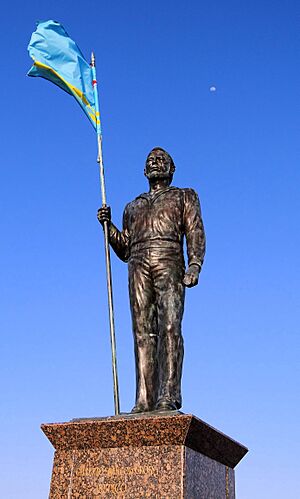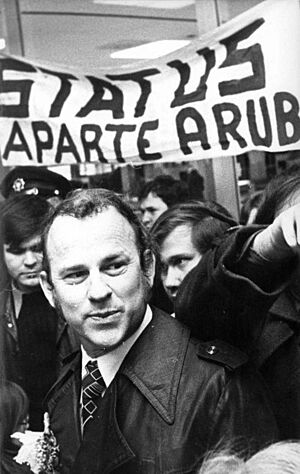Betico Croes facts for kids
Quick facts for kids
Betico Croes
|
|
|---|---|

Croes in 1982
|
|
| Born |
Gilberto François Croes
25 January 1938 Santa Cruz, Aruba
|
| Died | 26 November 1986 (aged 48) Utrecht, Netherlands
|
| Occupation | teacher, politician |
| Children | 2 sons, 2 daughters |
Gilberto François "Betico" Croes (Papiamento pronunciation: [beˈtiko kɾus]; 25 January 1938 – 26 November 1986) was an important Aruban political leader. He strongly believed that Aruba should become separate from the Netherlands Antilles. This goal was finally reached in 1986. Sadly, Croes was in a car accident on December 31, 1985, the very night Aruba gained its special status. He fell into a coma and never woke up to see his dream come true. People remember him as "Libertador," which means "liberator," and as the father of the Aruban people.
Contents
Betico Croes: His Life and Work
Betico Croes was born on January 25, 1938, in Santa Cruz. After finishing high school, he went to a Teacher's Training College in Hilversum, Netherlands. He earned his headmaster's certificate in 1959. This meant he could lead a school.
In 1967, Croes joined the Aruban People's Party (AVP). He was elected to the island council of Aruba. This council helped govern the island. He left the AVP in July 1970.
In February 1971, Croes started his own political party. It was called the People's Electoral Movement (Movimiento Electoral di Pueblo), or MEP. He was then elected to the island council again. In 1973, the MEP won many seats for Aruba in the Estates of the Netherlands Antilles. This was a big step for his party.
In 1976, Croes played a key role in creating Aruba's national symbols. He was responsible for the Aruban Flag and the National Anthem. The anthem was co-written by famous artists Padu Del Caribe and Rufo Wever.
Understanding the Netherlands Antilles
In 1954, the Netherlands Antilles became a constituent country of the Kingdom of the Netherlands. This meant it had its own government but was still part of the larger Kingdom. Aruba was the second-largest island in the Antilles. However, Curaçao was the biggest and had the most people.
The Estates of the Netherlands Antilles was like a parliament. Aruba had 8 seats in this parliament. Curaçao had 12 seats. Other islands like Bonaire, Saba, Sint Eustatius, and Sint Maarten had fewer seats. The capital city was Willemstad, located in Curaçao.
Fighting for Aruba's Independence
Betico Croes wanted Aruba to be more independent. In 1977, he organized a special vote called a referendum. This vote asked people if they wanted Aruba to be independent. The government of the Netherlands Antilles said the vote was not allowed. They also said they would not accept the results. Despite this, 95% of the voters chose independence in March 1977.
In June 1977, Boy Rozendal won the elections in the Netherlands Antilles. He was against Aruba gaining more freedom. Rozendal formed his government without talking to Croes's party, the MEP. Because of this, Croes called for protests and asked people to stop buying products from Curaçao.
On August 11, 1977, a big general strike happened on Aruba. The island almost completely shut down. Police had to step in many times. On August 18, union leaders were arrested, and the strike ended. However, the Prime Minister of the Netherlands, Joop den Uyl, started talks. He saw that the situation was getting out of control.
In February 1981, a meeting called the Round Table Conference took place. At this meeting, Croes officially asked for Aruba to become fully independent by 1991. Later, in 1983, another Round Table Conference was held. This meeting led to a new plan. Aruba would get a Status Aparte in 1986. This meant Aruba would become its own constituent country within the Kingdom of the Netherlands. Full independence might then happen in 1996.
On April 24, 1983, Croes was shot by a police officer. The officer was later moved to Bonaire. In November, the Public Prosecution Service decided not to charge the officer. They said there was no proof he had aimed at Croes.
In July 1985, the plan for Aruba's special status was approved. The island council of Aruba voted for it without anyone disagreeing. This Status Aparte was set to begin on January 1, 1986.
In the 1980s, Croes also suggested that Aruba should focus on tourism. This was to make the economy stronger. Before, Aruba mostly depended on its oil refinery. He also helped create important projects for the people of Aruba. These included the housing company FCCA and the transportation company Arubus.
1985 Elections and His Passing
In November 1985, Betico Croes's party, the MEP, lost the election. Henny Eman from the Aruban People's Party (AVP) became the first Prime Minister of Aruba.
On December 31, 1985, Croes was in a traffic accident. He fell into a coma. He passed away on November 26, 1986, in a nursing center in Utrecht, Netherlands. His body was flown back to Aruba for burial. About 40,000 people attended his funeral. This was a huge number, as Aruba had around 65,000 people in 1985.
A famous quote from him is: "Si mi cai na caminda, gara e bandera y sigui cu e lucha" This means, "If I fall along the way, grab the flag and continue the battle."
His Family Life
Betico Croes had four children. He had two sons, Glenbert Croes and Gilberto Junior Croes. He also had two daughters, Glendeline Croes and Guisette Croes.
Both of his sons later became government ministers. As of 2021, Glenbert is serving as the Minister of Labor, Integration, and Energy.
His Lasting Legacy
- Betico Croes Day is celebrated every year on his birthday, January 25. It is a national holiday in Aruba.
- The 18 Maart Plein in Oranjestad was renamed Plaza Betico Croes in his honor.
- Caya G. F. Betico Croes is named after him. It is the main shopping street in Oranjestad, the capital of Aruba.



